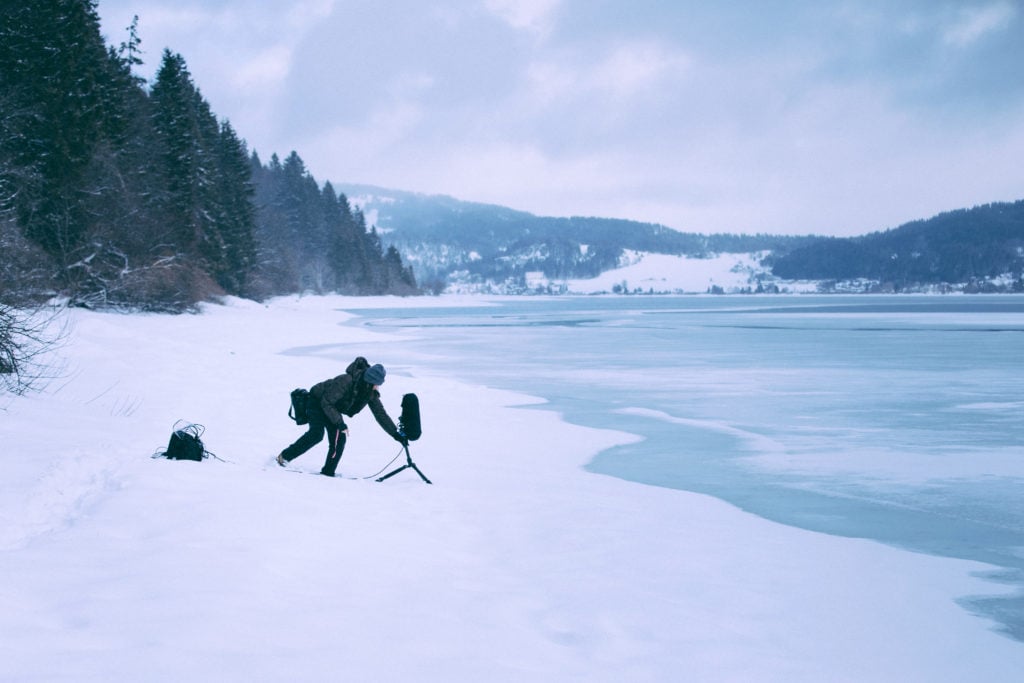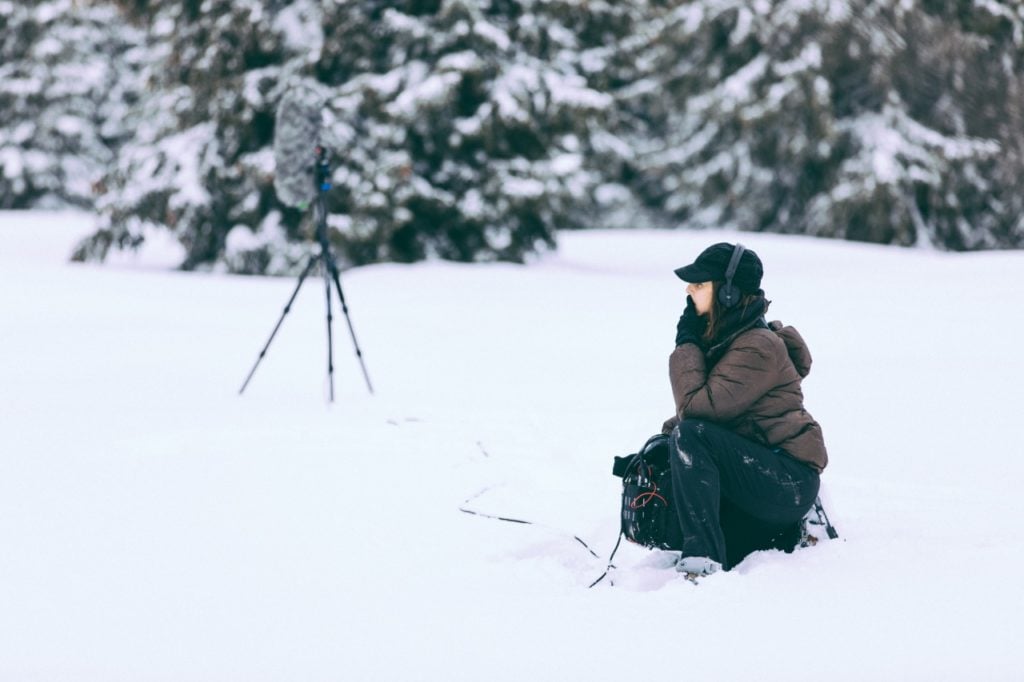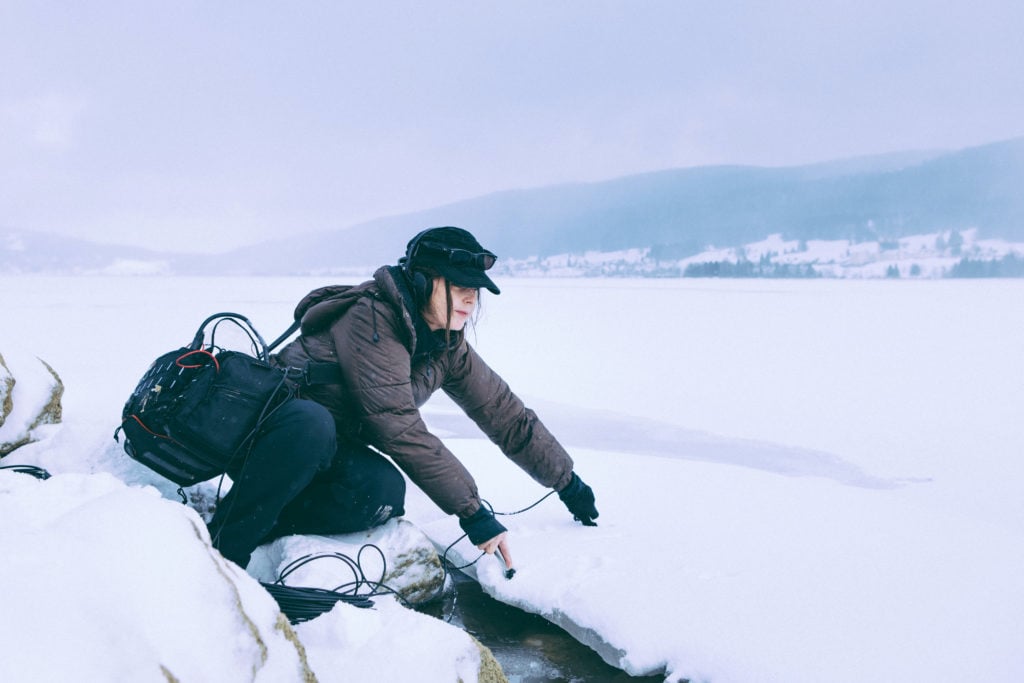Art World
‘Images Are Never the Full Story’: Artist Jana Winderen on How She Brought the Sounds of the Swiss Jura Mountains to Art Basel
The artist's work for the fair taps into the ecosystem of the Vallée de Joux.

The artist's work for the fair taps into the ecosystem of the Vallée de Joux.

In Partnership with Audemars Piguet

At Swiss watchmaker Audemars Piguet’s Art Basel lounge this week, Norwegian sound artist Jana Winderen debuted a new installation that documents the sounds of the unique habitat of the Vallée de Joux in the Swiss Jura Mountains, home to the company’s Manufacture for the last 144 years.
The composition, which comprises several tracks, is for Winderen a chance to acquaint listeners with a deeper, more layered understanding of the landscape. Her recordings capture rarely heard aspects of the world, and illustrate how the buzz of human life can sometimes obscure the quieter sounds of the surrounding environment.
“When you hear a sound, you also often visualize something,” she says. “We tend to think about things in visual terms, but we are surrounded by sounds all the time. It is part of our experience, as smell is, or a breeze, or a drift of air that we sense on our skin. All this information adds together regarding how we perceive the world, how we perceive a situation.”
We spoke with Winderen about the making of her work, what she hopes listeners will take away from it, and what it’s like to be a sound artist today.

“I like the openness with sound, because before you can reflect, it goes directly to your emotions,” the artist says. Courtesy of the artist and Audemars Piguet.
How did you come up with the concept for your project?
It started with a site visit to Audemars Piguet in the Swiss village of Le Brassus. I was guided around the [Manufacture] and began noticing its surroundings in this beautiful area, in the Jura Mountains. I saw images of the building’s architectural design and also learned about its origins: where the [Manufacture] started, what influenced Jules Louis Audemars and Edward Auguste Piguet to create it, that sort of thing. So I began looking at the production of their watches for inspiration too. Then I went outside to get a sense of the environment in which the [Manufacture] sits.
Early on, I was also told about the Audemars Piguet’s lounge design for Art Basel. I knew that there would be a lot of people sitting around in the lounge, there to meet and talk.That’s the first sound environment I had to factor in. We can’t really control the ebbs and flows of conversation, so I started to think about how that layer of talking would connect to the piece. I decided to create a simple sound installation of the [Manufacture’s] surrounding environment that would work together with the talking of the visitors who would be listening to it at Art Basel. The challenge became: how to work with the talking, instead of against it?
Tell me about the project itself. You visited the Swiss Jura Mountains twice to record these tracks. What did each visit contribute?
The second time I visited, I decided to record the dawn chorus by the lake—when birds are waking up. It’s an intense, natural sound situation. Very often, you will find that human beings are still asleep at that time. I also wanted to do the same in the forest area. When I first visited, I became really excited about the 300-year-old trees, and the resonant quality of one type of spruce tree used for musical instruments, like violins and cellos. They’re very slow-growing trees. So I was excited to revisit the forest and understand more about how it’s looked after. I liked the idea of the trees observing time passing more slowly than we do: they’ve seen so many generations of people, animals, birds, insects, and whole ecosystems come and go.
When I went back there, what shocked me was how after a certain hour in the morning, maybe at 5 or 6 a.m., human noise overtakes everything. When you take a photograph of this environment, it looks like the most peaceful place on the planet, but when you record it, the microphone won’t filter out sounds you might not want to hear. Human noise was really dominant, like the sound of cars and air traffic in the early morning. On my second visit, it was about realizing how much sound we’re putting into the environment and how much we’re doing to it. It’s an indicator of how much stress we’re causing to other animals. We’re so unaware of how difficult we make life for other species.

“It’s almost like sculpting and drawing,” the artist says of sound art. “But it doesn’t take up any storage except hard disk space.” Courtesy of the artist and Audemars Piguet.
What do you like about being a sound artist?
I decided in 1992 that I didn’t want to create any more physical objects. I was working with sculpture, actually, and I was starting to make large objects and it didn’t make sense to me anymore to continue making these objects and to store them somewhere and participate in this production-driven process. I wanted to make sound-based work, which is almost like sculpting and drawing, but it doesn’t take up any storage except hard disk space.
I like this openness with sound, because before you can reflect, it goes directly to your emotions; it’s visceral. It’s a way for me to point to specific issues. For example, in the underwater world, I like that I can surprise people with the fact that fish are making this sound. And they ask about it and I can tell stories from the different environments I’ve visited and their particular issues. So for me, it’s also a way to point to specific issues in terms of how we are treating the planet and the ecosystems that we’re part of.
What are you hoping listeners will take away from the listening experience in the lounge?
I’m hoping listeners can start noticing our environment more and take more care of how we treat it. Of course, images are never the full story, no matter how beautiful they are, and we’re saturated with those today. Hopefully, you gain more information by also listening. In my work I try to encourage listeners to listen to the stories of people that know an area very well, and understand the realities of life there.